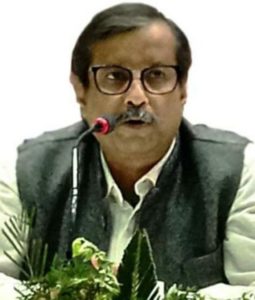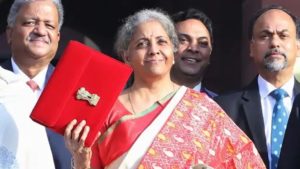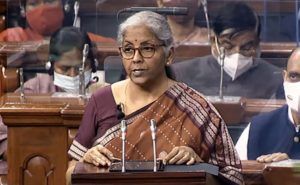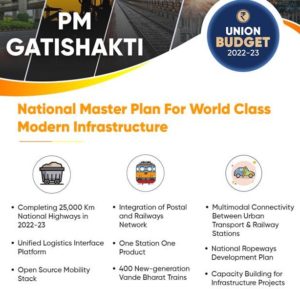AnalyticsBreaking News
A visionary Budget for 2022-23 to transform India by 2047 throughout the Amrit Kaal, writes Prof. Niranjan Roy


Feb. 1: In Vedic astrology, the ‘Amrit Kaal’ is a vital time window when the gate of higher pleasure is opened for society at large. It is seen to be the best and most fortunate moment. Prime Minister Narendra Modi in his last Independence Day speech proposed an ambitious development plan for the country for the next 25 years, dubbed as “Amrit Kaal” (a period of emancipation), until India’s centennial of independence in 2047, and announced a slew of development programmes, including a landmark Rs 100 lakh crore “Gati Shakti” initiative to boost infrastructure and employment opportunities.
 In tune with that vision, the budget 2022-23 aims to lay the groundwork for the economy to steer across the “Amrit Kaal” of the next 25 years, from India @ 75 to India @100, while continuing to build on the vision of the previous budget. Health and well-being, infrastructure, inclusive development, energy transition and climate action, investment financing, minimum government, maximum governance is among the budget proposals for this fiscal year. Digital currency, e-passports, and a slew of infrastructure projects are among the major announcements. Edible oil, wearable electronics, replica jewellery, and polished diamonds will all be less expensive. The fiscal deficit is 6.9% of GDP. Persons with disabilities have been granted tax reductions. There will be no changes to personal income tax rates.
In tune with that vision, the budget 2022-23 aims to lay the groundwork for the economy to steer across the “Amrit Kaal” of the next 25 years, from India @ 75 to India @100, while continuing to build on the vision of the previous budget. Health and well-being, infrastructure, inclusive development, energy transition and climate action, investment financing, minimum government, maximum governance is among the budget proposals for this fiscal year. Digital currency, e-passports, and a slew of infrastructure projects are among the major announcements. Edible oil, wearable electronics, replica jewellery, and polished diamonds will all be less expensive. The fiscal deficit is 6.9% of GDP. Persons with disabilities have been granted tax reductions. There will be no changes to personal income tax rates.
 This budget 2022-23 has focused on three important goals of Amrit Kaal:
This budget 2022-23 has focused on three important goals of Amrit Kaal:
- focus on growth and all-inclusive welfare
- promoting technology-enabled development, energy transition and climate action and
- virtuous cycle starting from private investment, crowded in by public capital investment.
 Amid pandemic India’s GDP growth is estimated at 9.2% in 2022-23 which is to be the highest among large economies in the globe. This simply indicates strong macro fundamentals of the economy steered by efficient governance. Accordingly, in this budget four priorities have been identified to accelerate economic growth with a focus on Atmanirbharata. The priorities are PM Gati Sakti driven by seven engines: road, railways, airports, ports, mass transports, waterways and logistic infrastructure. This is aimed at world-class modern infrastructure and logistic synergy. The other priorities emphasized in this budget are inclusive development, productivity enhancement and investment, sunrise opportunities, energy transition and climate action, financing of investments.
Amid pandemic India’s GDP growth is estimated at 9.2% in 2022-23 which is to be the highest among large economies in the globe. This simply indicates strong macro fundamentals of the economy steered by efficient governance. Accordingly, in this budget four priorities have been identified to accelerate economic growth with a focus on Atmanirbharata. The priorities are PM Gati Sakti driven by seven engines: road, railways, airports, ports, mass transports, waterways and logistic infrastructure. This is aimed at world-class modern infrastructure and logistic synergy. The other priorities emphasized in this budget are inclusive development, productivity enhancement and investment, sunrise opportunities, energy transition and climate action, financing of investments.
 The budget declared formulation of a master plan for expressways, completing 25,000 km national highways in 2022-23. Finance Minister has also declared Unified Logistics Interface Platform allowing data exchange among all mode operators, Open Source Mobility Stack for seamless travel of passengers and 4 Multi-modal Logistic parks through Public-Private Partnership to be awarded in 2022-23. PM Gati Shakti national master plan is to be implemented for ₹20,000 crores. National Master Plan on Expressways will be formulated in 2022-23. In the railway sector, 400 new generations Vande Bharat trains are to be manufactured in the next 3 years. Other announcements include 60 km of ropeway projects under the parvat mala project, metro systems, multi-model connectivity and 100 Gati Shakti cargo terminals in the next 3 years.
The budget declared formulation of a master plan for expressways, completing 25,000 km national highways in 2022-23. Finance Minister has also declared Unified Logistics Interface Platform allowing data exchange among all mode operators, Open Source Mobility Stack for seamless travel of passengers and 4 Multi-modal Logistic parks through Public-Private Partnership to be awarded in 2022-23. PM Gati Shakti national master plan is to be implemented for ₹20,000 crores. National Master Plan on Expressways will be formulated in 2022-23. In the railway sector, 400 new generations Vande Bharat trains are to be manufactured in the next 3 years. Other announcements include 60 km of ropeway projects under the parvat mala project, metro systems, multi-model connectivity and 100 Gati Shakti cargo terminals in the next 3 years.
 To provide benefit and incentives to the farmers wheat, paddy, kharif, and rabi crops to be procured, benefiting nearly one crore farmers in this fiscal year. NABARD will facilitate a fund with blended capital to finance agricultural and rural enterprise startups. Direct payments for the minimum support price totalled 2.37 lakh crore. Natural, chemical-free farming will be encouraged across the country. The year 2022 will be designated as the Year of Millet, with support for millet post-harvest value addition. Using Kisan drones for crop evaluation and pesticide spraying, as well as the Rs 44,000 crore Ken-Betwa river connecting project, which will benefit 9.0 lakh hectares of agricultural land.
To provide benefit and incentives to the farmers wheat, paddy, kharif, and rabi crops to be procured, benefiting nearly one crore farmers in this fiscal year. NABARD will facilitate a fund with blended capital to finance agricultural and rural enterprise startups. Direct payments for the minimum support price totalled 2.37 lakh crore. Natural, chemical-free farming will be encouraged across the country. The year 2022 will be designated as the Year of Millet, with support for millet post-harvest value addition. Using Kisan drones for crop evaluation and pesticide spraying, as well as the Rs 44,000 crore Ken-Betwa river connecting project, which will benefit 9.0 lakh hectares of agricultural land.
To provide impetus to the Atmanirbharata domestic procurement in the defence sector receives a commitment of 68 per cent of the capital procurement in this fiscal year. Defence R&D will be made available to start-ups, commercial businesses, and academics. This will receive a quarter of the R&D expenditure. Military platforms and equipment will be encouraged to be designed and developed by the private sector.
 Education and health constitute important social sector investments. Digital University will be established, and to be made in different Indian languages, based on networked hub model. One Class, One TV channel will be expanded from 12 to 200 TV channels to provide supplementary education in all regional languages, to make up for the loss of formal education due to Covid. Similarly, on the health front, National Digital Health Ecosystem is to be rolled out. 23 National Tele Mental Health programs to be set up to focus on mental health. Integrated benefits to women and children will be ensured through Mission Shakti, Mission Vatsalya, Saksham Anganwadi and Poshan 2.0. Digital Ecosystem for Skilling and Livelihood (DESH-Stack e-portal) will be launched to empower citizens to skill, reskill or upskill through online training. Startups will be promoted to facilitate ‘Drone Shakti’ and for Drone-As-A-Service (DrAAS). Seven inclusive welfare schemes announced in this budget include:
Education and health constitute important social sector investments. Digital University will be established, and to be made in different Indian languages, based on networked hub model. One Class, One TV channel will be expanded from 12 to 200 TV channels to provide supplementary education in all regional languages, to make up for the loss of formal education due to Covid. Similarly, on the health front, National Digital Health Ecosystem is to be rolled out. 23 National Tele Mental Health programs to be set up to focus on mental health. Integrated benefits to women and children will be ensured through Mission Shakti, Mission Vatsalya, Saksham Anganwadi and Poshan 2.0. Digital Ecosystem for Skilling and Livelihood (DESH-Stack e-portal) will be launched to empower citizens to skill, reskill or upskill through online training. Startups will be promoted to facilitate ‘Drone Shakti’ and for Drone-As-A-Service (DrAAS). Seven inclusive welfare schemes announced in this budget include:
- Har Ghar, Nal Se Jal: 3.8 crore households to be covered in 2022-23
- PM Awas Yojana: 80 lakh houses to be completed in 2022-23
- PM-DevINE: To fund infrastructure and social development based on felt needs of the North East,
- Aspirational Blocks Programme: fr development of lagging blocks of aspirational districts
- Vibrant Villages Programme: Targeting development of villages on the Northern border left out from the development gains
- Digital Banking by Post Offices: 100% of post offices to come on the core banking system
- Digital Payments: Scheduled Commercial Banks to set up 75 digital banking Units in 75 districts
 In 2022-23, the RBI plans to launch a “digital rupee” based on block-chain technology. Virtual digital assets will be subject to a 30% tax. The receiver will be taxed if they receive virtual assets as a gift. In 75 districts, 75 digital banking units will be established.
In 2022-23, the RBI plans to launch a “digital rupee” based on block-chain technology. Virtual digital assets will be subject to a 30% tax. The receiver will be taxed if they receive virtual assets as a gift. In 75 districts, 75 digital banking units will be established.
Overall, the budget 2022-23 provides a futuristic and visionary road-map to create a strong foundation for the Indian economy through public investment measures. India being World’s sixth-largest economy emerges from a pandemic induced slump and is now on the road to recovery. Following the economic impact of the Covid-19 which caused a spike in unemployment in the last two years, a plan to increase domestic manufacturing and create jobs has been outlined in this budget. India’s commitment towards climate change mitigation efforts has been visible from different green initiatives announced in this budget. The entire world is looking at India for global sustainability. The budget kicks off Amrit Kaal, a 25-year countdown to India’s 100th birthday, by providing a boost to overall economic growth and a march towards ‘Viswaguru’.
**Prof Niranjan Roy teaches Economics in Assam University, Silchar. A scholar of repute, Prof Roy is the author of several well acclaimed books.





